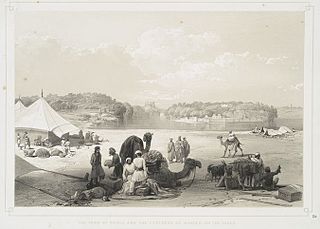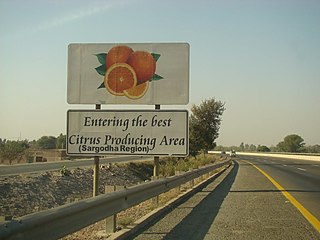
Punjab is one of the four provinces of Pakistan, with a population of about 110,000,000 as of 2021. Forming the bulk of the transnational Punjab region of Pakistan and India, it is bordered by the Pakistani provinces of Sindh, Balochistan, and Khyber Pakhtunkhwa, the enclave of Islamabad, and Pakistan administered Azad Kashmir. It also shares borders with the Indian states of Punjab, Rajasthan, and Jammu and Kashmir union territory. The capital is Lahore, a cultural, historical, economic and cosmopolitan centre of Pakistan where the country's cinema industry, and much of its fashion industry, are based. The largest cities of Punjab are Lahore and Faisalabad respectively. Faisalabad is the largest industrial city of Punjab. Punjab is also the world's fifth-most populous subnational entity, and the most populous outside China or India.

The partition of India was the division of British India in 1947 into two independent Dominions: India and Pakistan. The Dominion of India is today the Republic of India, and the Dominion of Pakistan is the Islamic Republic of Pakistan and the People's Republic of Bangladesh. The partition involved the division of two provinces, Bengal and Punjab, based on district-wide non-Muslim or Muslim majorities. The partition also saw the division of the British Indian Army, the Royal Indian Navy, the Indian Civil Service, the railways, and the central treasury. The partition was outlined in the Indian Independence Act 1947 and resulted in the dissolution of the British Raj, i.e. Crown rule in India. The two self-governing independent Dominions of India and Pakistan legally came into existence at midnight on 15 August 1947.

Gujranwala is a city and capital of Gujranwala Division located in Punjab, Pakistan. It is also known as "City of Wrestlers" and is quite famous for its food. The city is Pakistan's 5th most-populous metropolitan area, as well as 5th most populous city proper. Founded in the 18th century, Gujranwala is a relatively modern town compared to the many nearby millennia-old cities of northern Punjab. The city served as the capital of the Sukerchakia Misl state between 1763 and 1799, and is the birthplace of the founder of the Sikh Empire, Maharaja Ranjit Singh.
The Punjabis or the Punjabi people, are an Indo-Aryan ethnolinguistic group associated with the Punjab region in South Asia, specifically in the northern part of the Indian subcontinent presently divided between Pakistani Punjab and Indian Punjab. They speak Punjabi, a language from the Indo-Aryan language family. The term Punjab means the five waters from Persian: panj ("five") and āb ("waters"). The name of the region was introduced by the Turko-Persian conquerors of the Indian subcontinent.

Khatri is a caste, originally found in South Asia. Apart from India, they are also found in Afghanistan and Pakistan. Afghan Hindus and Sikhs are predominantly of Khatri and Arora origin.

Kasur is a city to south of Lahore, in the Pakistani province of Punjab. The city serves as the headquarters of Kasur District. Kasur is the 24th largest city of Pakistan by population. It is also known for being the burial place of the 17th-century Sufi-poet Bulleh Shah. It is farther west of the border with neighbouring India, and bordered to Lahore, Sheikhupura, and the Okara District of Punjab Province. The city is an aggregation of 26 fortified hamlets overlooking the alluvial valleys of the Beas and Sutlej rivers.

Kohli is a Khatri clan of Hindus and Sikhs originating from Punjab and parts of Jammu in Jammu and Kashmir in north-western India.

The Arora is a community of Punjab, comprising both Hindus and Sikhs. The name is derived from their native place Aror.

Sargodha District, is a district of Punjab, Pakistan. The capital of the district is Sargodha. It is an agricultural district, wheat, rice, and sugarcane being its main crops. The Sargodha district and region is also famous for citrus fruit including Kinnow, orange and lemon. The district has an area of 5,864 km2.

Sikhism in Pakistan has an extensive heritage and history, although Sikhs form a small community in Pakistan today. Most Sikhs live in the province of Punjab, a part of the larger Punjab region where the religion originated in the Middle Ages, with some also residing in Peshawar in the Khyber-Pakhtunkhwa province. Nankana Sahib, the birthplace of Guru Nanak Sahib Ji, the founder of Sikhism, is located in Pakistan's Punjab province. Moreover, the place where Guru Nanak is believed to have died, the Gurdwara Kartarpur Sahib is also located in the same province.

Pakpattan, often referred to as Pākpattan Sharīf, is the capital city of the Pakpattan District, located in Punjab province of Pakistan. It is the 48th largest city of Pakistan by population according to the 2017 census. . Pakpattan is the seat of Pakistan's Chisti order of Sufism, and is a major pilgrimage destination on account of the shrine of Fariduddin Ganjshakar, the renowned Punjabi poet and Sufi saint commonly referred to as Baba Farid. The annual urs fair in his honour draws an estimated 2 million visitors to the town.
Punjabi Hindus are an Indo-Aryan group who are adherents of Hinduism and identify linguistically, culturally, and genealogically as Punjabis. While Punjabi Hindus are mostly found in the Indian state of Punjab today, many have ancestry from the entire Punjab region, an area that was partitioned between India and Pakistan.

Phularwan, is a city located in the Sargodha District of Punjab province, Pakistan. It is a part of the tehsil of Bhalwal. It is the terminus of a branch of the North-Western railway.

Chak No. 129 N.B. commonly known as Unatti Moar is a village of Tehsil Sillanwali located at Sillanwali-Farooka Road on the western bank of Lower Jehulm Canal in Sargodha District, Punjab, Pakistan. It is headquarters of the Union Council No. 120, comprising Chak No's. 125, 126, 127, 128 and 129 N۔B.
According to the 2011 Census of India, Punjab, India has a population of around 27.7 million.

Farooqabad, earlier known as Choorkana "(چوڑ کانا)" is a city in Sheikhupura District, Punjab, Pakistan. It is situated along the twin canals about 55 km west of Lahore on Sargodha Road along Lahore-Islamabad M-2 Motorway and on Lahore-Faisalabad-Karachi Main Railway Line.
Sindhis in India are a socio-ethnic group of people originating from Sindh, a province of modern-day Pakistan. After the 1947 partitioning of British India into India and Pakistan, a million Sindhi Hindus migrated to India. As per the 2011 census of India, there are 2,772,364 Sindhi speakers in India.

Punjabi Muslims are adherents of Islam who identify linguistically, culturally, and genealogically as Punjabis. Primarily geographically native to the Punjab province of Pakistan today, many have ancestry in the entire Punjab region, split between India and Pakistan in the contemporary era. Forming the majority of the Punjabi ethnicity in the greater Punjab region. Punjabi Muslims speak or identify the Punjabi language as a mother tongue. With a population of more than 90 million, they are the largest ethnic group in Pakistan and the world's third-largest Islam-adhering ethnicity after Arabs and Bengalis. The majority of Punjabi Muslims are adherents of Sunni Islam, while a minority adhere to Shia Islam and other sects, including the Ahmadiyya community which originated in Punjab during the British Raj.

Lilla (للہ) is a small city and union council of Jhelum District in the Punjab Province of Pakistan. It is part of Pind Dadan Khan Tehsil,.

Arar Shareef or simply as "Arar" is a historic village located in Sahiwal Tehsil, Sargodha, Pakistan. It is nearby to the town of Farooqa, which is a mandi and central business hub since the British times. It is about 49 km (30.4 mi), south from Sargodha city. Geographically it lies on a Jech Doab between Sillanwali and Sahiwal Tehsil, Sargodha. Currently, the population of Arar is more than 1,000 approximately. Though its colonies can altogether be a count of many thousands.
















